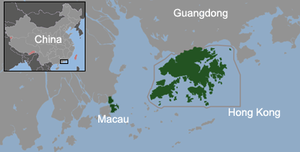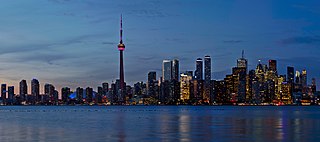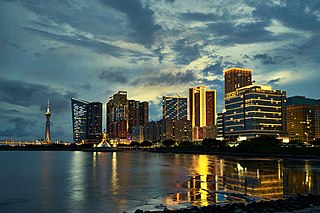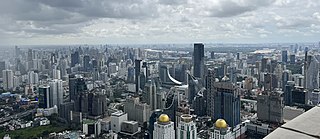 Central and Victoria Harbour of Hong Kong | |
| Currency | Hong Kong dollar (HKD) |
|---|---|
| 1 April – 31 March | |
Trade organisations | APEC, WTO, Group of Twenty (Chinese delegation), One Belt One Road, AIIB and ICC etc. |
Country group | |
| Statistics | |
| Population | |
| GDP | |
| GDP rank | |
GDP growth |
|
GDP per capita | |
GDP per capita rank | |
GDP by sector |
|
| 1.9% (2022) [5] | |
Population below poverty line | 19.9% (2016 est.) [6] |
| 53.9 high (2016) [6] | |
| |
Labour force | |
Labour force by occupation |
|
| Unemployment | 4.3% (2022) [5] |
Average gross salary | HK$ 19,100 US$ 2,439 per month (2022 May) [10] |
| HK$ 17,883 US$ 2,284 per month (2022 May) [11] | |
Main industries | financing and insurance, import and export trade, professional and business services |
| External | |
| Exports | $533.6 billion (2023) [5] |
Main export partners |
|
| Imports | $593.3 billion (2023) [5] |
Main import partners |
|
FDI stock | |
Gross external debt | |
| Public finances | |
| 0.1% of GDP (2017 est.) [6] | |
| +5.2% (of GDP) (2017 est.) [6] | |
| Revenues | 79.34 billion (2017 est.) [6] |
| Expenses | 61.64 billion (2017 est.) [6] |
| Standard & Poor's: [12] AAA (Domestic) AAA (Foreign) AAA (T&C Assessment) Outlook: Stable [13] Moody's: [13] Aa3 Outlook: Negative Fitch: [13] AA+ Outlook: Stable | |
| $430.7 billion (April 2023) [14] | |
The economy of Hong Kong is a highly developed free-market economy. It is characterised by low taxation, almost free port trade and a well-established international financial market. [15] [16] Its currency, called the Hong Kong dollar, is legally issued by three major international commercial banks, [17] and is pegged to the US dollar. [18] [19] Interest rates are determined by the individual banks in Hong Kong to ensure that they are market driven. [20] There is no officially recognised central banking system, although the Hong Kong Monetary Authority functions as a financial regulatory authority. [21] [22]
Contents
- Since the 1997 handover
- Positive non-interventionism
- Economic freedom
- Economic data
- GDP
- Labour
- 2022–2023 fiscal year budget
- Trade
- Poverty
- Financial markets
- Stock exchange
- Bond market
- Exchange rates
- See also
- References
- External links
Its economy is governed under positive non-interventionism, and is highly dependent on international trade and finance. For this reason it is regarded as among the most favorable places to start a company. In fact, a recent study shows that Hong Kong has come from 998 registered start-ups in 2014 to over 2800 in 2018, with eCommerce (22%), Fintech (12%), Software (12%) and Advertising (11%) companies comprising the majority. [23] The Economic Freedom of the World Index lists Hong Kong as the second freest territory, with a score of 8.55 based on data from 2021. [24]
Hong Kong's economic strengths include a sound banking system, virtually no public debt, a strong legal system, ample foreign exchange reserves with assets of US$481.6 billion represent over six times the currency in circulation or about 46 per cent of Hong Kong dollar M3 as at the end of March 2022, [25] rigorous anti-corruption measures and close ties with mainland China. [26] The Hong Kong Stock Exchange is a favourable destination for international firms and firms from mainland China to be listed, due to Hong Kong's highly internationalised and modernised financial industry. Additional advantages include the city's capital market in Asia, its size, regulations and available financial tools, which are comparable to London and New York City. [27] [28]
Hong Kong's gross domestic product had grown 180 times between 1961 and 1997. Also, the GDP per capita rose by 87 times within the same time frame. [29] Its economy is slightly larger than Chile's or Romania's [30] [31] [32] and its GDP per capita at purchasing power parity was the twelfth highest globally in 2023. By the latter measure, its GDP per capita was higher than those of the Netherlands, and slightly lower than Brunei. In 2009, Hong Kong's real economic growth fell by 2.8% as a result of the Great Recession. [33]
By the late 20th century, Hong Kong was the seventh largest port in the world and second only to New York City and Rotterdam in terms of container throughput. Hong Kong is a full Member of the World Trade Organization. [34] The Kwai Chung container complex was[ when? ] the largest in Asia, while Hong Kong shipping owners were[ when? ] second only to those of Greece in terms of total tonnage holdings in the world. The Hong Kong Stock Exchange is the sixth largest in the world, with a market capitalisation of about US$3.732 trillion. [35]
Hong Kong has also had an abundant supply of labour from the regions nearby. A skilled labour force coupled with the adoption of modern British/Western business methods and technology ensured that opportunities for external trade, investment, and recruitment were maximised. Prices and wages in Hong Kong are relatively flexible, depending on the performance and stability of the economy of Hong Kong. [36]
Hong Kong raises revenues from the sale and taxation of land and through attracting international businesses to provide capital for its public finance, due to its low tax policy. According to Healy Consultants, Hong Kong has the most attractive business environment within East Asia, in terms of attracting foreign direct investment (FDI). [37] In 2013, Hong Kong was the third largest recipient of FDI in the world. [38]
Hong Kong ranked fourth on the Tax Justice Network's 2011 Financial Secrecy Index. [39] The Hong Kong Government was the fourth highest ranked Asian government [40] in the World Economic Forum's Network Readiness Index (NRI), a measure of a government's information and communication technologies in 2016, and ranked 13th globally. [41]





















